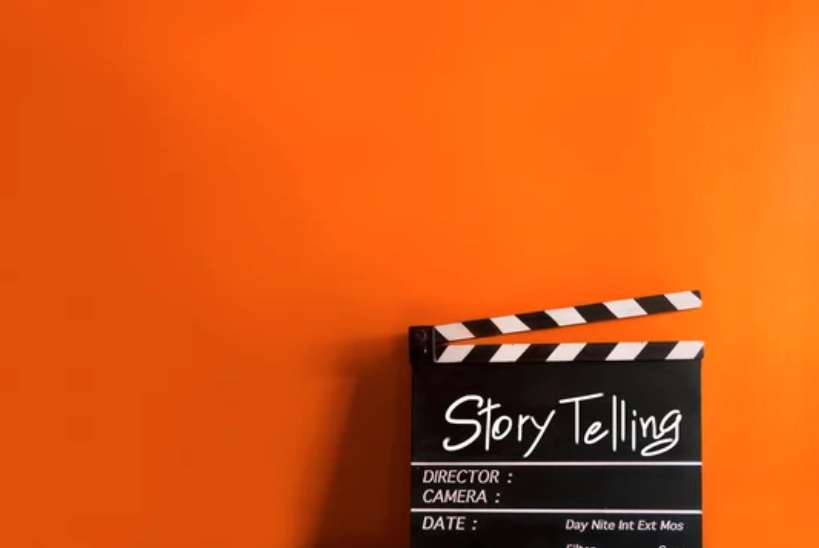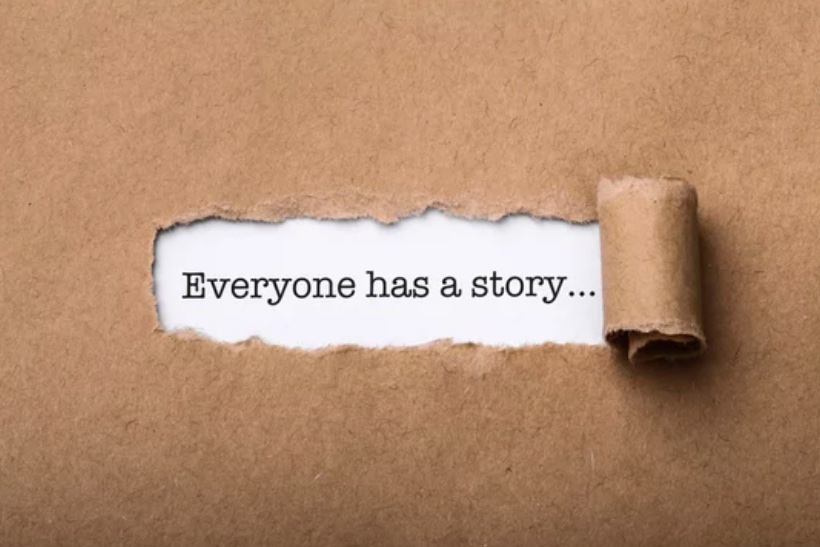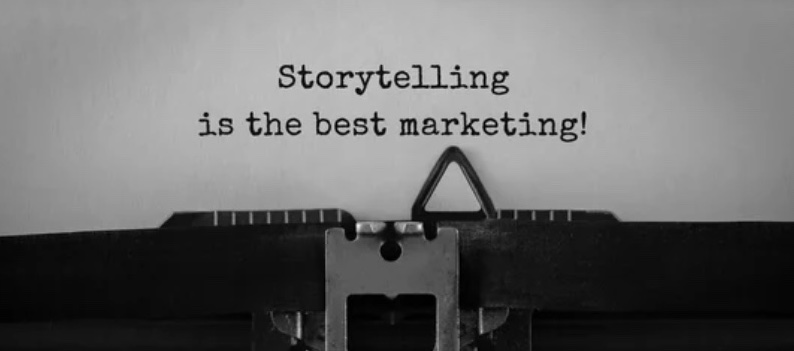Why Employees Need Storytelling for Personal Branding

In the competitive landscape of corporate America, having a strong personal brand can make or break your career. While we often think of a personal brand as more appropriate for entrepreneurs or public figures, it is a critical component for employees at all levels who want to stand out, advance their careers, and make a lasting impact within their organizations. So, how do you build a personal brand at work? Storytelling, of course. The Role of Personal Branding in Career Success Carving a path for yourself in corporate America takes vision, planning, and a strategy. You should absolutely use storytelling to help you reach the next level. In a crowded job market, personal branding helps you stand out. You differentiate yourself from others by clearly articulating who you are, what you value, and what you bring to the table. A strong personal brand makes you more memorable and can open opportunities for career advancement. At the risk of sounding like a broken record: Be yourself! Consistent and genuine storytelling fosters trust. When colleagues, managers, and stakeholders understand your values and see consistency in your actions and words, you build a reputation of integrity. This trust can lead to increased responsibilities, promotions, and leadership opportunities. Personal branding increases your visibility within and outside your organization. By sharing your stories, achievements, and insights, you position yourself as a thought leader and a valuable contributor. This visibility can attract mentors and networking opportunities that are crucial for career growth. Real-World Examples The women listed below enjoyed or enjoy long careers at big-name companies in part because they use storytelling to bolster their personal brands. Strategies for Maintaining a Consistent and Authentic Personal Brand Storytelling can help you grow your career into the future you see for yourself. Here are five tips to help you create your personal brand strategy: Final Thoughts If you’re interested in taking steps up the corporate ladder, personal branding through storytelling can help you on your journey. Stories build trust and boost your visibility, and a compelling personal brand opens up new opportunities and drives career success. Embrace storytelling as a primary tool to achieve your career aspirations and make a lasting impact in your organization.
Use Storytelling to Advance Your Career

Simply doing your job well — and even exceeding expectations on a consistent basis — isn’t always enough to advance your career. To stand out amongst your peers, you need to effectively communicate your contributions and achievements, and you should use storytelling to do it. By sharing your personal and professional stories, you highlight your unique skills, experiences, and the value you bring to their organization. The Power of Storytelling in Career Advancement Stories allow you to illustrate your achievements in a more memorable way. Rather than simply stating that you completed a project successfully with the requisite reports, provide a written narrative about the challenges you faced, the innovative solutions you implemented, and the impact your work had on the company. This approach makes your accomplishments more relatable and creates a lasting impression. Sharing personal stories at work about how your values align with the company’s can be a powerful way to build connections and demonstrate your commitment. However, the timing and context must be right to ensure it feels natural and authentic: Storytelling helps you build a personal brand within your organization. By consistently sharing stories that showcase your strengths, values, and accomplishments, you create a narrative that defines who you are as a professional. This can make you more recognizable and valuable to your managers. Examples of Career Advancement Through Storytelling When I researched this article, I found a lot of stories of folks who have grown powerful personal brands for lucrative entrepreneurial and speaking careers. What you need, though, are examples of folks who worked or work in corporate America and used storytelling to create career paths that led them to the top. How You Can Use Storytelling to Advance Your Career Follow the examples above and the tips below to put you on your own path to wherever you want to go in your career: Final Thoughts Storytelling is not just for entrepreneurs, companies, and nonprofit organizations. You should absolutely use stories to advance your career by highlighting your contributions and showcasing your values to build a personal brand. The point is to communicate your value to your current employer and position yourself for career advancement. Learn from the successful examples listed above to embrace the power of storytelling to elevate your professional journey and achieve your career goals.
Storytelling as a Tool to Fulfill Your Nonprofit’s Mission

For your nonprofit organization, staying true to its mission and effectively communicating its values are critical. Storytelling can be one of the most powerful tools to help your nonprofit to fulfill its promise. Incorporating it into your organization’s communication strategy highlights its impact, engages your audience, and reinforces your mission. The Role of Storytelling in Fulfilling a Nonprofit’s Mission Storytelling allows nonprofits like yours to communicate their core values in a relatable and impactful way. Through stories, your organization can show rather than tell what its stand for and why its work matters. This helps to build a stronger emotional connection with supporters and stakeholders. Stories provide a concrete way to demonstrate the outcomes of a nonprofit’s work. By sharing the experiences of beneficiaries, your nonprofit can illustrate the direct impact of its programs and services. This not only validates the organization’s efforts but also motivates donors and volunteers to continue their support. Engage and educate audiences with stories to make complex issues more understandable and relatable. Use storytelling to raise awareness about the causes your nonprofit supports, explain the challenges it faces, and inspire action. By sharing stories from diverse perspectives—beneficiaries, volunteers, staff, and donors—your nonprofit can build a sense of community and shared purpose. By taking an inclusive approach, you foster a sense of belonging and encourage internal and external stakeholders to continue their involvement. Case Studies of Successful Storytelling Well-known organizations use storytelling all the time to spread the word about how they keep the promises they make to the people they serve and the donor who support them. The American Cancer Society uses storytelling to communicate the impact of its research, advocacy, and patient support services. Through their “Survivor Stories” series, they share personal accounts from cancer survivors, providing hope and inspiration to others affected by the disease. These stories are featured on their website, social media, and fundraising campaigns, effectively aligning with their mission to save lives and celebrate life. Pencils of Promise focuses on building schools and providing educational opportunities in developing countries, integrates storytelling into their mission-driven work. They share stories of students, teachers, and communities transformed by their programs. These narratives highlight the importance of education and the tangible results of their efforts, helping to attract donors and volunteers who are passionate about education. Feeding America is a nationwide network of food banks, and teams there use storytelling to raise awareness about hunger and food insecurity in the United States. By sharing stories of individuals and families who have benefited from their services, they personalize the issue and demonstrate the critical role their organization plays in alleviating hunger. This approach helps to mobilize support and drive donations. Tips for Implementing a Storytelling Strategy So, how can your nonprofit organization use storytelling to better fulfill its mission? Final Thoughts Storytelling is a powerful tool that can help your nonprofit organization stay true to its mission and communicate its values effectively. By highlighting its impact, engaging and educating audiences, and building a sense of community, storytelling can drive support and amplify the reach of your nonprofit’s work. Organizations like the American Cancer Society, Pencils of Promise, and Feeding America have successfully integrated stories into their mission-driven work and provides real-world examples to inspire and mobilize action. Through storytelling, nonprofits can harness the power of storytelling to fulfill their mission and achieve their goals.
Storytelling Can Boost Your Nonprofit Fundraising Efforts

Securing funding is a constant challenge for nonprofit organizations, and storytelling can make it easier. When nonprofits can engage donors on an emotional level by demonstrating the value of their work, they have a much better chance of attracting more funding. The Impact of Storytelling on Fundraising Stories have the unique ability to connect with people on an emotional level. When donors hear about the personal experiences of those helped by your nonprofit, they empathize and feel a part of the mission. This emotional connection often translates into a willingness to donate. For example, how often have you watched TV late at night and been surprised by an ad for Save the Children? The visual storytelling about the struggles and triumphs of children in need makes their cause relatable and urgent for potential donors. Through stories, your nonprofit can show the real-world effect of your work. Instead of just presenting statistics, stories put a human face on the numbers to help donors understand the tangible difference their contributions make. The American Red Cross, for instance, shares survivor stories from disaster relief efforts, illustrating how donations have directly aided individuals and communities in crisis. Transparency is crucial for building trust with donors. Sharing stories about how their funds are used and the outcomes boosts your nonprofit’s credibility. Donors want to be assured that their money is making a positive impact. A well-crafted story serves as a call to action. By highlighting urgent needs, your organization can motivate people to act through donations, volunteering, or advocacy. The World Wildlife Fund often shares stories about endangered species and conservation efforts, inspiring supporters to contribute to their cause. Real-Life Examples In addition to the organizations listed above, the ones illustrate the power of storytelling and should help you gain a greater understanding of how to use it to your organization’s advantage. The Trevor Project focuses on crisis intervention and suicide prevention for LGBTQ+ youth. By sharing stories from individuals who have been helped, the organiztion illustrates the critical need for their work and the positive outcomes it generates. This approach has helped them secure funding and support from a broad audience. Heifer International has a mission to end hunger and poverty by providing livestock and training to communities in need. They share stories of families whose lives have been transformed by their programs. By demonstrating the long-term impact of their work, they show how a simple donation can lead to sustainable change and economic independence. Ronald McDonald House Charities (RMHC) uses storytelling to connect with donors and volunteers by sharing heartfelt stories of families who benefit from their support during medical crises. These stories are often shared through videos and social media and highlight the comfort and assistance provided to families. In this way, RMHC makes a compelling case for continued support and donations. Tips for Crafting Powerful Fundraising Stories Your nonprofit should absolutely incorporate storytelling to attract donors and larger contributions. Here are five tips to help you either get started or to bolster your current efforts: Final Thoughts Storytelling can significantly boost your nonprofit’s fundraising efforts because when you emotionally engage your audience, you can attract more funding and support for your mission. Learn from successful organizations like The Trevor Project, Heifer International, and Ronald McDonald House Charities about how to demonstrate impact, build trust, and inspire action so you can attract more funding and support for your cause. Embrace the power of storytelling to drive your mission forward.
Transforming Employees into Powerful Brand Ambassadors

Did you know your employees can be you company’s most effective brand ambassadors? Remember when we talked about public relations as the third-party credibility you need to grow your business? Think of your employees sharing their personal stories and experiences working for you as the ultimate public relations win. Employee testimonials boost your company’s image and enhance employee engagement and loyalty. The Benefits of Employee Brand Ambassadors When employees share their stories, they add a personal touch to your company’s image. Customers are more likely to trust and engage with a brand that feels human and relatable. Personal stories from your employees highlight your company’s values and mission in a way that resonates more deeply with your audience. Encouraging employees to share their stories can significantly increase their engagement and satisfaction. It gives them a sense of ownership and pride in your company because they feel valued and heard. The result is that your team members are likely more motivated and committed to their work. Potential employees often look for insights into a company’s culture before deciding to apply. Stories shared by your current employees can provide an authentic glimpse into what it’s like to work for you, making it more attractive to top talent. Additionally, a strong internal storytelling culture can improve retention by creating a sense of community and belonging. Employees often have their own networks on social media and other platforms. When they share stories about working with and for you, they help expand your brand’s reach organically. This can lead to increased brand awareness and a broader customer base. Real-Life Examples I know having real-life examples of companies that use employee ambassadors to grow their businesses are helpful, so let’s dig in: Microsoft encourages its employees to share their personal and professional stories through the “Microsoft Life” blog and social media channels. These stories highlight the diverse experiences and backgrounds of Microsoft employees and showcase the company’s inclusive culture. This approach has helped Microsoft humanize its brand and attract a diverse talent pool. Zappos is known for its strong company culture and employee engagement. The company encourages its employees to share their experiences and stories on social media and through the “Zappos Insights” blog. This storytelling approach has helped Zappos build a loyal customer base and attract employees who are passionate about the company’s values. Ben & Jerry’s successfully uses employee storytelling to enhance its brand. The company encourages its employees to share their experiences and stories about working at Ben & Jerry’s to publish on the company’s blog and social media platforms. These stories highlight the company’s commitment to social justice, environmental sustainability, and community involvement. This approach strengthens the brand’s image and fosters a sense of pride and loyalty among employees. 5 Tips for Creating a Culture that Promotes Storytelling Even with a small team, you can absolutely create a company culture where employees are excited to come to work and tell their family, friends, and extended networks why it’s so great to work for you. Here’s how to make it happen: Final Thought Transforming employees into powerful brand ambassadors through storytelling humanizes your brand, boosts employee engagement, enhances recruitment and retention, and expands your brand reach. Companies like Microsoft, Zappos, and Ben & Jerry’s successfully use storytelling to drive their brands forward, and you can, too. pkv qq result togel togel hari ini slot gacor hari ini website pcnu malang Website Resmi PCNU Daftar Situs QQ Online BcaQQ PT Perkebunan Nusantara Inovasi Judi Online Ptpn11 Link Situs BandarQQ Permainan QQ Online Link Alternatif BandarQQ Stie Aprin Daftar BandarQQ Online bandarqq jackpot Judi Bandar QQ Online bandarqq link situs dominoqq https://businessprojects.my.id/ Link Daftar BandarQQ Agen PKV QQ Link Judi Online Situs Judi Bola Link BandarQQ DominoQQ Link BandarQQ Online Link Situs BandarQQ Link Situs DominoQQ PKV Games Resmi Terbaik idpro BandarQQ Daftar BandarQQ Online Situs Pkv QQ Online idpro pkv qq mix parlay malam ini daftar situs mix parlay agen judi bola bbm88 bandar judi bola INDOBET365 situs judi bola terpercaya bcaqq pkv games judi dominoqq cmcpoker botakqq pkv games botakqq mataqq Agen Judi PKV Games Daftar BandarQQ Ompkv Ompkv Situs Judi Online BandarQQ PKV Games Asli Terpercaya Link Situs CmcPoker Daftar Pkv Games Terbaik Situs Judi BandarQQ Online Mataqq Pkv Games Resmi Link Judi Poker Online Situs Bandar QQ BcaQQ streaming film jav18+ Indobet365 Situs Judi Bola SITUS JUDI BOLA INDOBET365 When you create a culture of safety, provide platforms, recognize individual contributions, offer training, and lead by example, you create a culture that promotes and values storytelling. Embrace the power of storytelling within your team to unlock their full potential and drive your organization forward.
Connecting with Your Customers Through Stories

Connecting with your customers on a deeper level is more crucial than ever. While quality products and services are important, they aren’t enough to foster long-term customer loyalty. What truly makes your brand stand out is your ability to build trust and emotional connections with your audience. One of the most effective ways to achieve this is through authentic storytelling. The Power of Authentic Stories Stories help us meet new people, learn about other cultures, and travel to places we might not otherwise have the opportunity. Most importantly, though, stories connect us to each other. Successful Entrepreneurs Who Use Storytelling Thanks to the power of social media and content marketing, we know more about brands and their founders than ever before. Truly successful entrepreneurs leverage their stories to create and grow their personal and business brands. judi qq daftar bandarqq login bandarqq judi bola terpercaya agen taruhan bola situs qq online bandarqq situs judi bola bandarqq login daftar bandarqq link bandarqq situs judi bola bandarqq online link bandarqq bandarqq judi bola indobet365 agen judi bola situs poker online bandarqq bandarqq pkv bandarqq online situs pkv games bcaqq bbm88 mataqq botakqq mataqq cmcpoker botakqq botakqq botakqq botakqq botakqq alternatif botakqq botakqq slot gacor hari ini link slot gacor judi bola judi bola kofbola judi kof bola judi kof bola bandarqq botakqq Judi Poker QQ Online Situs Judi BandarQQ Online Platform Gaming BandarQQ PKV Situs Idpro PKV QQ Pkv QQ Daftar Login BandarQQ botakqq Pkv QQ Online Followers Terbanyak Uang Sampingan QQ Online Link Akun Pro BandarQQ Situs Games Online BandarQQ DOMINOQQ LINK AGEN PKV QQ SITUS QQ ONLINE UANG ASLI SITUS JUDI KARTU BANDARQ ONLINE MAIN BANDARQQ ONLINE PKV QQ SITUS JUDI BANDARQQ SITUS PKV QQ RESMI BandarQQ Situs QiuQiu Online Link Login Situs DominoQQ Daftar 17 Permainan BandarQQ Daftar BandarQQ Online Situs Judi Penghasil Cuan Situs Penghasil Cuan Terbaik Daftar BandarQQ Online Akun Pro BandarQQ Akun Pro BandarQQ Situs Judi Poker BotakQQ 3 Strategies for Sharing Authentic Stories Keeping it real is the key. The stories you share must be the real deal; tell the truth because customers want to get to know you, not the version you think they’ll like best. Final thoughts Storytelling is a powerful tool for building trust and emotional connections with your customers. By sharing your personal and business stories, you humanize your brand, create memorable experiences, and differentiate yourself from the competition. As the examples of Sara Blakely, Blake Mycoskie, and Daymond John show you, effective storytelling can transform your brand and foster long-term customer loyalty. Incorporate these strategies into your branding efforts and watch as your audience becomes not just customers, but advocates who believe in your mission and share your story. Authentic stories resonate the most and leave a lasting impact.
Public Relations Is the Credibility You Need

While marketing gets the bulk of the attention given to how to promote your book, you can’t ignore public relations. So, what’s the difference? In a nutshell, marketing is you talking about yourself, and public relations (PR) is having other people talk about you. Think about when you see ads online or in a magazine or you see a post by someone you follow telling you about their latest and greatest. You may or may not remember them. But a story posted online by a trustworthy news source or in a magazine or newspaper with a byline? Chances are higher you not only remember what you read, you believe it. PR gives you what marketing and ads never can: third-party credibility. The Power of a Press Release The more people know about your book, the more copies you’ll sell, and a press release can help get you there. For the purposes of this example, I’m referring to your local media; print (newspapers, business journals, and magazines) and broadcast (local news affiliates such as ABC, CBS, FOX, NBC) in the town or city where you live. Local media needs a steady stream of compelling stories from the communities they serve, and your press release helps them do their jobs at the same time you get needed visibility. Because PR is so powerful, this is where you use the power of storytelling to work its magic so it resonates with your neighbors. Get Visible and Get Paid Visibility isn’t just about being seen; it’s about elevating your personal brand and boosting your business profile. With attention being the new currency, appearing in local media can open doors to new opportunities. You and your book featured in the local newspaper or on the nightly news is the gift that keeps on giving through SEO. By placing the news article or segment on your website and linking to the appropriate media, you create valuable connections from your site to pages with higher ranking authority, making it more likely for you to list higher in a Google search. Teknik Fotografi Terbaru Mediterranean Charm History Discover Trendy Unique Fashion Tempat Terbaik untuk Kuliner Akses Mudah Cara Login Info Berita MLBB Terbaru platform nonton gratis situs bola mix parlay agen situs judi bola agen judi bola indonesia sbobet sbobet88 SBET11 Slot Server Luar Negeri Situs Sbet11 Why Your Local Media Matters Local media outlets are deeply invested in the communities they serve with a loyal audience that turns to them for news they can use. By tapping into this market, you could find your next best customer. My editing business is an online business, and my clients are spread across the U.S., and I’m sure your business is structured in much the same way. If we don’t engage our local media, we dismiss the power of proximity; we pass on the possibility to create collaborations and partnerships to help us grow that much faster. Leverage Every local media appearance can be used as a stepping stone to greater things. Leverage these opportunities to build momentum by saying, “As featured in …”, and, “As seen on …”. You’ll be amazed at how sharing your media appearances on social media, in newsletters, and on your website maximize your reach. Most importantly, appearing on your local NBC morning show, for instance, can lead to regional and national media. Complete Story Package = Content Stretched While a press release does pack a powerful punch, the truth also is that your local writers, reporters, and editors are stretched pretty thin. By delivering a complete story package that includes a well-written press release, high-quality images, and maybe even a video segment, you make their job easier. Even better? By delivering a story that’s almost ready to publish or air, you increase your chances of being featured. Research Writers and Reporters Before you send your press release to anyone, be sure you’re targeting the right writer or reporter. You don’t want to send your press release about your new vegan cookbook to someone who covers major league sports teams. Newspaper reporters, for example, typically cover a beat; they focus on sports or education or business. Broadcast news reporters are usually more general unless they cover sports or are a meteorologist. Start with the outlet’s website; for newspapers, look at features, food, local news, and city news, for example. Which reporters write about the community such as nonprofit organizations, festivals, or individuals doing good in their neighborhoods? That’s who you want to target. As a general rule for both print and broadcast, it’s also not a bad idea to send your package to the department head or assignment editor, respectively. Your Pitch Letter The note that accompanies your email should be short and to the point. You need a great hook to make the recipient want to read more. This is a real lead I wrote for someone and it piqued the interest of at least one publication and two news stations: In corporate America, white women earn just 82 cents for every dollar a man makes, and the numbers are even more stark for Black women and Latinx women. What if contributing a chapter to an anthology could help more women not just get caught up but get ahead of the game? Next, introduce yourself briefly as, “Local author and entrepreneur NAME has a book about TOPIC …” and then tie it to something currently in the media. End your note with, “I’m available for an interview and look forward to hearing from you/one of your reporters soon. Best regards, NAME”. Both tactics let the writer, reporter, or editor know you understand what resonates with their audiences and the kind of stories they typically cover. You demonstrate that you’ve done your homework and can be a trusted source. The Fortune Is in the Follow Up Just as you would follow up with potential clients who don’t commit right away, you need to be just as persistent about PR. Follow up your initial pitch with a
6 Steps to Earning 6 Figures with Your Book

Writing a book can be one of the more lucrative ventures you absolutely should undertake. You have the opportunity to turn your expertise and experience into substantial income. If you are an entrepreneur, there really is no downside to writing a book about your zone of genius. Writing Writing your book doesn’t start with writing your book. First, you need to have an ideal reader in mind. Then, you need to know how your solution is the answer to their problem. Focus on how your knowledge of your topic resonates with your target audience. By sharing your command of the subject plus personal stories, you create the opportunity to connect with your reader. Now you can start writing. Begin with a first word, then a sentence, and now a paragraph. Keep going! Editing Editing is the most critical and the most expensive step of your publishing journey and for good reason. Your editor will catch grammatical and punctuation errors, understands sentence structure, and ensure consistency and congruency. Your editor makes sure your book meets industry standards and appeals to readers. Publishing After editing concludes, you move into publishing, and you have a choice: traditional or self publishing. There are pros and cons for each. Should you choose the traditional route, you need an agent who will shop your book to various publishers. There are significant benefits of having a publishing house’s support, such as carrying the cost of printing copies of your book and distribution on your behalf. Self-publishing, on the other hand, offers more control and higher royalties, but can require a substantial investment up front if you want to host book signing events and/or throw a launch party where attendees can buy copies of your book. Fun fact: Fewer than 40% of traditionally published authors are women or female-identifying while self-publishing features nearly 70% women or female-identifying authors. Marketing No matter if you choose traditional or self publishing, the lion’s share of the marketing sits squarely on your shoulders and is how you’ll sell your book. As Most of us already have an online presence, and you’ll want to put yours to work like never before. Build a website, leverage social media, use your business’s email list, create collaborations and partnerships with brands in your same lane, and network both in person and online. You should also collect reviews and testimonials from those who read your book prior to release and customers you’ve helped through your business (as long as the book is in alignment, of course). There is real power in this level of engagement. Public Relations Do not dismiss the power of proximity. I’m talking to service-based businesses, especially, who operate primarily online. We may serve clients who live on each coast and every point in between, but our next best client could be just across town. Reach out to you local TV stations, newspapers, and magazines. Send them a press release about your brand story, offer yourself as a subject matter expert about a current event, and, most importantly, send them a photo and/or a video with your release. Local reporters and busy and appreciate good content with news their viewers and readers can use. Monetization Your book opens the door to unlimited earning potential. In addition to royalties from book sales, you can command larger speaking fees, you can offer coaching and courses, you can leverage it as a business card for your personal and professional brands. Once you become a published author, you are considered an expert. This enhances your credibility and leads to consulting roles and/or higher-level job opportunities. Final thoughts Your well-executed book has the potential to significantly boost your profile and your income. Enrolling in a writing program, paying for an editor, and publishing your book is an investment in your personal and professional brands and a stepping stone to diverse revenue streams. If you’re ready to write your book, please schedule a call.
The Benefits of Writing a Book About Your Area of Expertise

We live in a highly competitive and knowledge-driven era, and simply knowing your field and/or your industry better than others won’t be enough to truly set you apart. Writing a book about your zone of genius, though, can be a game changer. Writing a book about your area of expertise is not just for academics or celebrities; as a professional or an entrepreneur or a thought leader — and this applies across industries — you absolutely should get your knowledge out of your head and into the hands of readers. Here’s why: Your Book Establishes You as a Thought Leader In your field, you might be well-known for your expertise, but how many others outside your immediate circle know you and could benefit from working with you? A book cements your knowledge and experience among your peers and puts you in front of new audiences. Your book also showcases how you think, identify and approach problems, and provide solutions. Building your book on a defined trajectory where you present insights, personal experiences, and clearly connected dots supports your position as a thought leader. Enhancing your credibility in this way opens the door for additional speaking engagements at higher price points, participating in panel discussions at prestigious industry events, and securing media features for increased social proof. In short, you’re amplifying your reach. Your Book Enhances Your Personal Brand and Reputation In addition to really knowing your field, your market niche, and your industry, you must also consider yourself as a brand and define the promise you (as a brand) deliver. Writing a book gives you a distinctive edge that helps define your professional identity and control the narrative of your expertise. Your book demonstrates your active participation in your field and your industry. You also highlight your contribution and willingness to articulate your expertise, your experiences, and the wisdom you’ve gained along the way. Your Book Creates New Opportunities to Grow Your Business Writing a book instantly stamps you as an expert, so think of your book as the most effective business card you could ever create. Conversations about your book can lead to a new connection such as attracting new clients or sparking a new partnership, strengthen a current connection, or impress potential investors. Your book is also an additional stream of revenue. Readers are more likely to seek your services, buy your products, or engage with you or your business on a deeper level through courses, webinars, workshops, and merchandise. Your Book Fosters Your Personal and Professional Development While your book may focus on the more professional side of your life, the writing process will almost certainly include a good measure of personal growth. As you reflect on your journey and write about it in a way that connects with your ideal reader, you’ll clarify your experiences, theories, and belief systems. You gain deeper understanding of your knowledge and identify opportunities to explore new ideas. Final thoughts As you move toward placing the final period at the end of your last sentence, you’ll feel the headiness of excitement and anticipation mixed with a touch of anxiety. You started AND finished the book that’s lived in your head for 10 years. Be sure you celebrate. Take time to revel in your accomplishment. You earned it. Of course, now you need to market and sell your book, but that’s a blog for another day.
